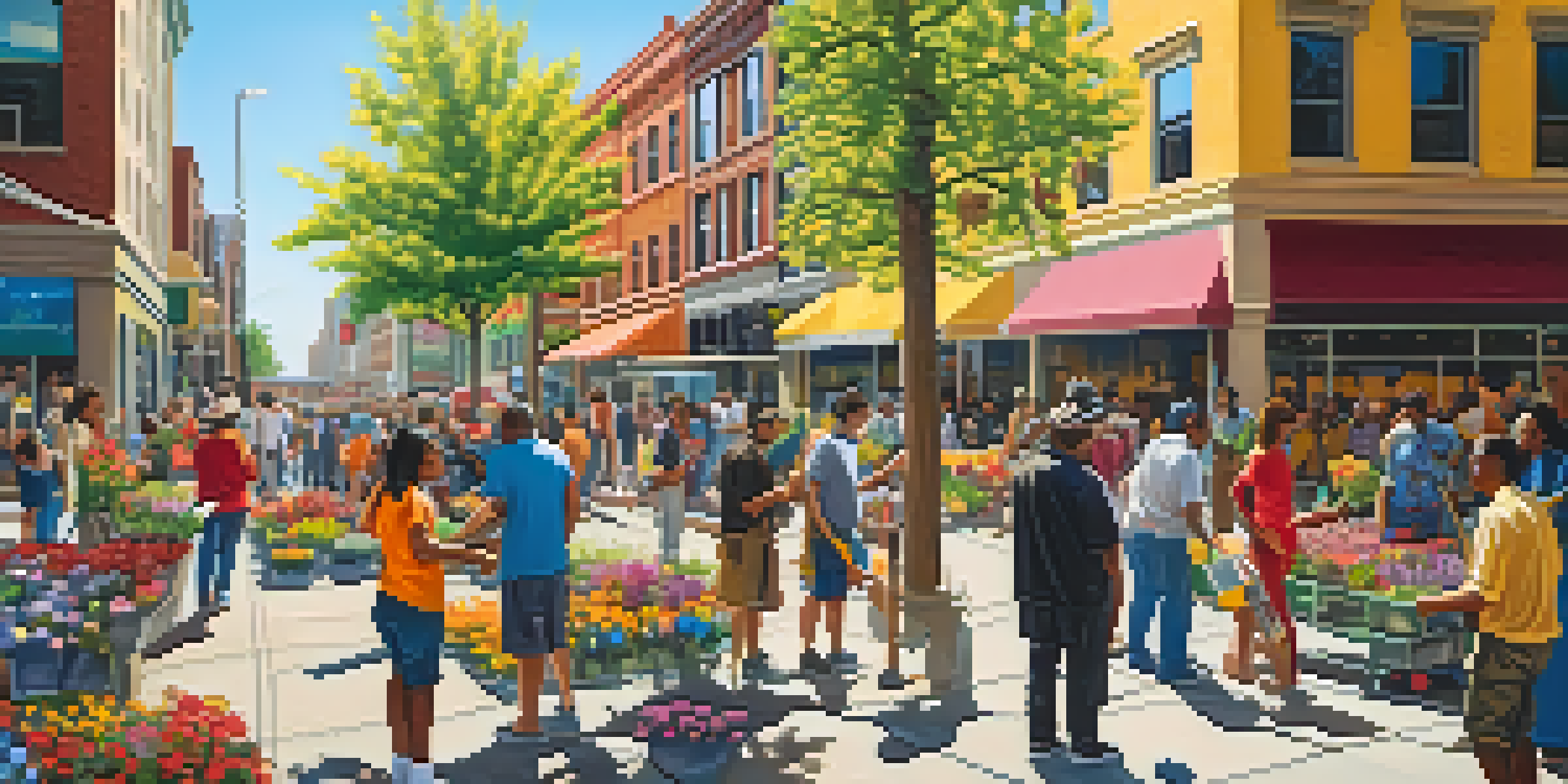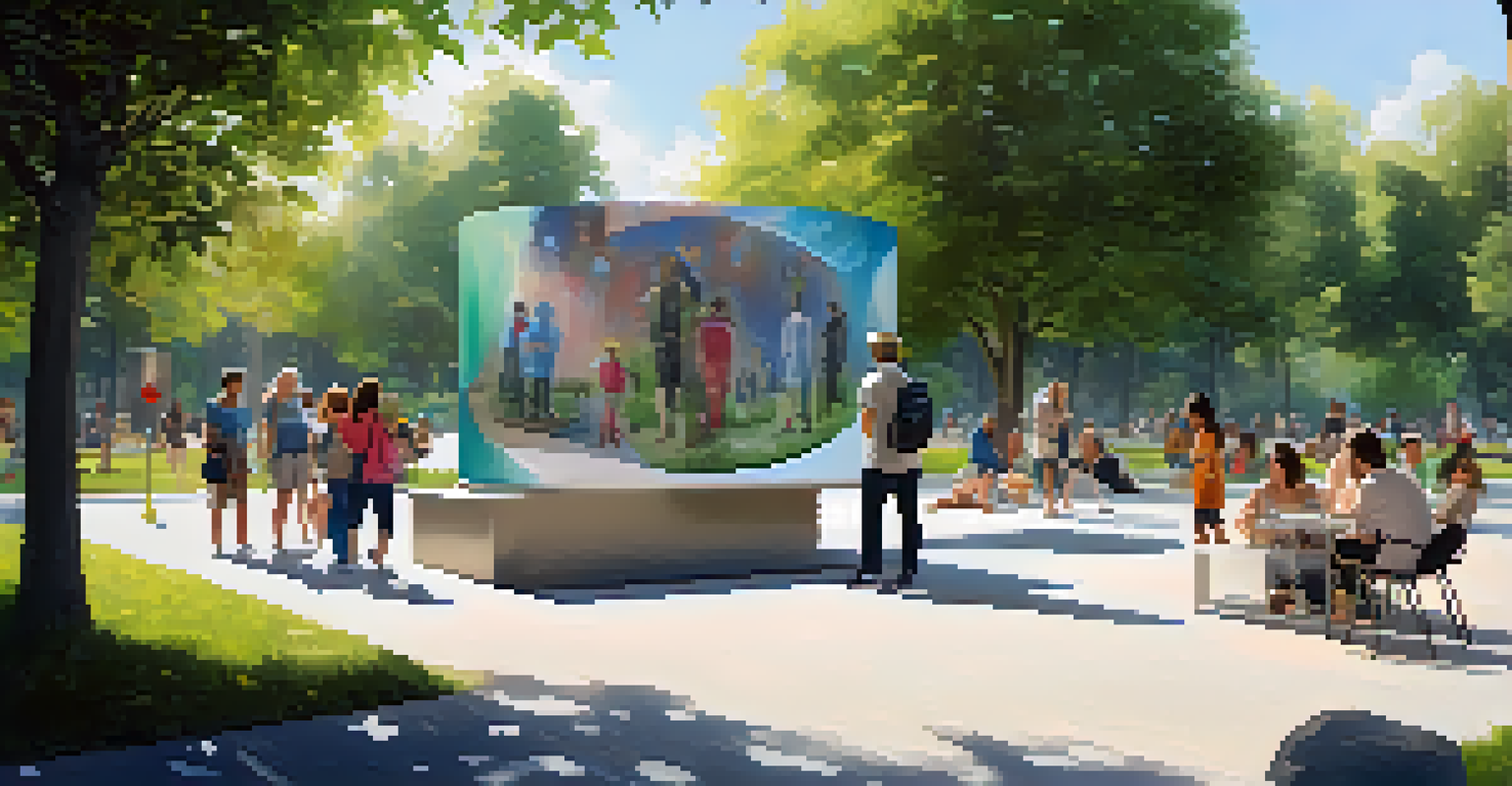Benefits of Collective Art Projects for Urban Revitalization

Understanding Urban Revitalization Through Art
Urban revitalization is a process aimed at improving neglected or declining areas, often involving economic, social, and environmental strategies. Collective art projects play a pivotal role in this transformation by enabling community engagement and fostering a sense of ownership. When residents come together to create art, they not only beautify their surroundings but also strengthen community ties and pride.
Art enables us to find ourselves and lose ourselves at the same time.
Art becomes a catalyst for change, sparking conversations about the neighborhood's identity and future. It encourages collaboration across diverse groups, making everyone feel included in the revitalization process. Through collective art, communities can express their unique stories and aspirations, contributing to a vibrant urban landscape.
Moreover, these projects can attract attention and interest from outside the community. Local businesses often benefit as foot traffic increases, leading to economic opportunities. The ripple effect of collective art projects is far-reaching, positively impacting both the community and the local economy.
Fostering Community Engagement and Connection
One of the most significant benefits of collective art projects is their ability to bring people together. When individuals collaborate on creative endeavors, they form meaningful connections, breaking down barriers and fostering understanding. This sense of community can be particularly vital in urban areas where anonymity often prevails.

Art serves as a universal language, allowing people from various backgrounds to express themselves and share their perspectives. This engagement can lead to deeper conversations about local issues, encouraging residents to work together toward common goals. By participating in these projects, individuals feel more invested in their community, which can lead to lasting positive changes.
Art Boosts Community Engagement
Collective art projects foster connections among residents, breaking down barriers and encouraging collaboration.
Additionally, collective art projects can inspire future generations to get involved. When young people see their neighbors creating and celebrating their culture, they are more likely to engage in community activities. This kind of involvement can reshape their understanding of civic duty and participation, creating a cycle of engagement.
Enhancing Public Spaces with Art Installations
Collective art projects often result in stunning public art installations that enhance the visual appeal of urban spaces. Murals, sculptures, and interactive art pieces can transform dull areas into vibrant destinations that attract both locals and tourists. These installations can serve as landmarks, fostering a sense of pride and identity within the community.
Creativity takes courage.
Beyond aesthetics, these projects can also make public spaces more functional and welcoming. For example, a community garden combined with artistic elements can encourage more people to gather and enjoy the outdoors. This transformation can lead to increased social interaction and a stronger community bond.
Moreover, well-designed public art can spark interest in urban exploration. Visitors are often drawn to neighborhoods with unique art, leading to an uptick in local tourism. This can provide vital support for nearby businesses, creating a thriving economy around the arts.
Promoting Cultural Heritage and Diversity
Collective art projects are an excellent platform for celebrating cultural heritage and diversity within urban settings. They allow communities to showcase their unique histories, traditions, and values through artistic expression. This not only honors the past but also educates others about different cultures, fostering respect and appreciation.
Art has the power to tell stories that might otherwise go unheard. By inviting community members to contribute their experiences and perspectives, collective art projects can highlight the richness of diversity. This representation is crucial in urban areas, where various cultures often intersect and interact.
Art Drives Economic Growth
These initiatives attract visitors and investment, creating job opportunities and stimulating local economies.
Additionally, showcasing cultural heritage through art can attract visitors and promote cultural tourism. People are often curious about local culture, and art installations can serve as entry points for deeper exploration. This engagement can strengthen community identity while enhancing the overall urban experience.
Encouraging Economic Development Through Art
Collective art projects can be significant drivers of economic development in urban areas. By attracting visitors and potential investors, these projects can lead to increased foot traffic and revenue for local businesses. When art becomes a focal point of the community, it can stimulate interest and investment in the surrounding area.
Furthermore, these initiatives often require collaboration with local artists, artisans, and vendors, creating job opportunities. As the community invests in its creative economy, it fosters a cycle of growth that benefits everyone involved. The arts can serve as an economic engine, driving innovation and entrepreneurship.
Moreover, successful art projects can inspire future initiatives, leading to a more vibrant community. They demonstrate how creative endeavors can yield tangible economic benefits, encouraging stakeholders to continue investing in the arts. This ongoing commitment can transform the urban landscape for the better.
Strengthening Mental Health and Well-being
Engaging in collective art projects can significantly enhance mental health and well-being within communities. Creative expression has been shown to reduce stress, anxiety, and depression, providing an outlet for emotions and fostering resilience. When individuals participate in group art initiatives, they often experience a sense of belonging and purpose.
The act of creating art together can also lead to cathartic experiences, allowing participants to process their feelings and share their stories. This shared vulnerability can build trust and camaraderie among community members, enhancing social bonds. As people connect through art, they often find solace and support in one another.
Art Enhances Mental Well-being
Engaging in creative expression through art reduces stress and fosters a sense of belonging in communities.
Additionally, these projects can offer a sense of achievement and pride. Completing a collective art piece fosters a feeling of accomplishment that can boost self-esteem and encourage further engagement. This positive impact on mental health can ripple throughout the community, promoting overall well-being.
Building a Sustainable Future with Collective Art
Collective art projects can also contribute to sustainability and environmental awareness in urban areas. Many initiatives focus on utilizing recycled materials or promoting eco-friendly practices, encouraging communities to think about their impact on the planet. This focus on sustainability can foster a sense of responsibility and stewardship among residents.
Moreover, art can be used as a tool for advocacy, raising awareness about local environmental issues. Collective projects can engage the community in discussions about sustainability, leading to actionable solutions. By incorporating art into these conversations, communities can visualize their goals and inspire collective action.

As urban areas face increasing environmental challenges, integrating art into sustainability initiatives can play a vital role in creating a greener future. Collective art projects not only beautify neighborhoods but also align with broader goals of environmental stewardship and social responsibility.